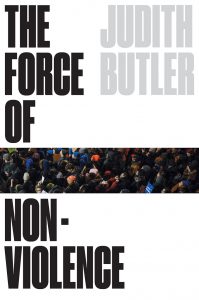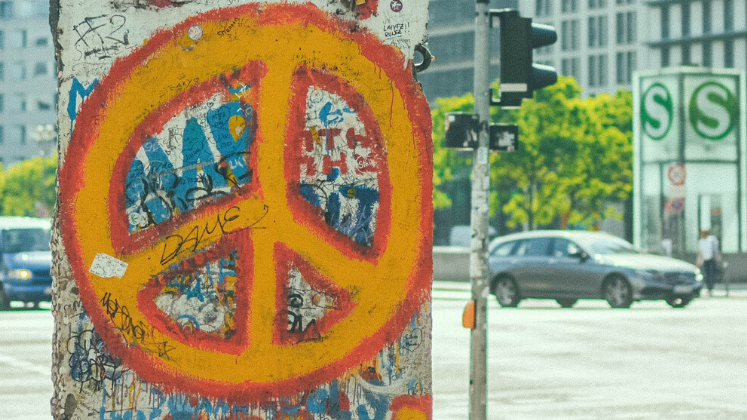In The Force of Non-Violence, Judith Butler challenges the prevailing ways in which violence and nonviolence have been understood, arguing that the distinction between the two has been founded on a harmful individualist paradigm. The book inspires a cautious yet hopeful optimism as it calls for a new interpretation of violence, and with it, a new imagining of nonviolence as a collective form of political action, writes Hesham Shafick.
The Force of Non-Violence: The Ethical in the Political. Judith Butler. Verso. 2020.
 The blurriness of the line that delineates violence and nonviolence has long been an open secret. Judith Butler’s The Force of Non-Violence argues that this ambivalence should not undermine ‘the task of critical thought in order to expose the instrumental use of that distinction that is both false and harmful’ (7). Following from this, she argues for the necessity of transcending the prevalent instrumentalist framework – which assumes that violence is a mere tool to enact a prescribed end – and explores the prospects that arise once we abandon this paradigm. For if ‘violence is always interpreted’ (14, emphasis in the original), then perhaps an alternative interpretation of violence could bring forth new possibilities for its amelioration. The book is an exploration of this possibility.
The blurriness of the line that delineates violence and nonviolence has long been an open secret. Judith Butler’s The Force of Non-Violence argues that this ambivalence should not undermine ‘the task of critical thought in order to expose the instrumental use of that distinction that is both false and harmful’ (7). Following from this, she argues for the necessity of transcending the prevalent instrumentalist framework – which assumes that violence is a mere tool to enact a prescribed end – and explores the prospects that arise once we abandon this paradigm. For if ‘violence is always interpreted’ (14, emphasis in the original), then perhaps an alternative interpretation of violence could bring forth new possibilities for its amelioration. The book is an exploration of this possibility.
This examination demands that we challenge the limits of our bounded imagination. The instrumentalist approach to violence and nonviolence and the prevalent feeling that it is hardly possible to distinguish the two concepts ‘ontologically’ – that is, beyond the focus on their consequential ends – are both products of a sense of obligation, ethical and epistemic, to think within the realistic limits of the possible. Butler suggests freeing ourselves from that obligation. She argues that these realistic limits are not essential, although they are defiant and persistent, for they are products of a neoliberal understanding that is historically and discursively specific. A change in the discourse of violence and nonviolence could, therefore, build up an alternative set of realistic possibilities.
Following from the above, Butler encourages her readers to abandon the prevalent individualistic, and neoliberal, conception of the self. This discourse, which implies that the act of violence and the commitment to nonviolence are individual acts, enacts two deep conceptual problematics. First, it conceptually condones silence regarding objective violence, where no particular individual actor could be held accountable. Second, it gives way to violence as an act of self-defence, without taking into consideration the repertoires this act of the individual self – be it an individual person, movement or nation – instigates and reproduces on the wider societal level.

Credit: Doğukan Şahin on Unsplash
In Butler’s account, both nonviolence and self-defence do not fully exist unless we think of society as a whole, rather than as a set of individuals. It is only when our interconnection as one globe is properly emphasised that we evade the limbo of performing harm against others in pursuance of pushing harm away from us. When the conception of ‘us’ becomes inclusive of ‘them’, self-defence becomes about defending us all – ending harm and violence. Self-defence becomes conditioned by nonviolence and nonviolence becomes the only real act of self-defence.
The rejection of individualism Butler suggests goes beyond the reductively simplistic appeals to empathy and coexistence. She rather refuses the conceptual grounds of such a fictitious notion of an individual: the Hobbesian myth that we miraculously came to the world as autonomous, independent and hence self-interested individuals. This fictional structure presumes violence, for it makes it intuitive that these disparate individuals would fight over resources, territory and dominance. Accordingly, it precludes the possibility of imagining nonviolence beyond one of two options: as an act of abstention from competition over resources and the concession to the structural violence this abstention would give rise to; or as a contractual reciprocity, the core and only value of which lies in its social instrumentalism. In both cases, violence lurks in the background and nonviolence is incomplete. As long as we exist as individuals, nonviolence could only be an act – contractual or passive, but never a normalised social condition.
But alternative possibilities could arise from allowing ourselves to think beyond the fiction of individualism and its implied order of normalised aggression. First, once we put aside the individual as an object of defence, one main ground of justification for war and violence – self-defence – becomes pacified. Self-defence does not cease to exist but rather becomes a defence of the universe as one united self; in doing so, it becomes no longer possible to commit abuse by targeting an ‘other’. Violence, then, becomes unjustifiable; and the only possible route to (universal) self-defence becomes nonviolence.
Second, violence becomes essentially conceived in its broader sense, beyond being the individualistic presumption that a violent act must be executed by one person against another. Transcending this fiction of individuality means transcending the fiction of violence as a one-on-one act, making structural, symbolic, institutional and other forms of objective violences appear as equally problematic. Accordingly, the project of nonviolence becomes realised in its broader sense. It becomes more than a mere refrain from subjecting an ‘other’ to violence to be inclusive of the equally important endeavour of eradicating the social conditions of violence and violent social conditions.
Third, it makes us able to see how our liberal ethics of nonviolence and self-defence are infiltrated by a demographic imaginary – a fictitious imagination that divides the world into demographic units of age, race, nations, etc – upon which all grounds of ‘legitimate’ violence are based. This imaginary division of society implies a demographic hierarchy of lives that matter, which justifies the loss of some humans with less socially assigned value as a legitimate expense for securing the lives of humans with higher value. By realising the fictional character of this hierarchical demography, this gives way to thought and action that imbue our relational obligations as an interdependent global community. For all that to be achieved, ‘we do need an altered state of perception, another imaginary, that would disorient us from the givens of the political process’ (64).
The problem arises from the fact that we are already embedded in the givens and discourses of our world: we already think, imagine and act within a neoliberal framework. The way out, Butler argues, lies in Sigmund Freud’s concept of Mania. For Freud, individualistic violence sprouts from the libidinal energy of our ego. We want to show force as individuals – that is, show our existence – and we exercise violence as evidence of this existence. This could get nasty, however. And so, we tend to put this under control through another force: the superego. Its exercise of control is in itself an exercise of violence, but against the self. The extreme form of such superego violence is suicide. And it is in this extreme form, and particularly in the reluctance to carry out such an act, that the force of mania becomes most valuable. Mania, this borderline insanity, is what makes the person on the verge of suicide not take their life. Not that one stops and rationally rejects the decision, but the mania allows one to imagine other-worldly possibilities, and hence a happier ending. It is this, precisely, that Butler wants us to do in our imagination of an alternative world. Situated at the edge of human suicidal violence directed against itself, it is time, she hints, to be a bit manic.
Mania, however, is not pure insanity. It is thinking a little bit beyond what seems to be the limits. The rest of the book is a rational proposition to push these limits towards radical nonviolence. Butler points out three main sets of limits. The first is the imaginary limits of individualism. The second is the demographic limits that divide and rule the population based on racial and gender ‘phantasms’ (illusionary imaginations of collective behaviour which set limits by rendering abject the option of behaving otherwise). Third, and most obviously, the structural constructs that institutionalise these limits and accordingly legitimise their administrative violence. These limits, Butler argues, are the main grounds that constitute the prevalent condition of violence. And overturning them is the route to the possibility of recreating a nonviolent world anew.
The Force of Non-Violence provides a catalogue of this alternative performance of social being: one that seems, like most of Butler’s propositions, unrealistic, but the strength of which lies precisely in its unrealism. Judging by what Butler’s theorisation of gender performativity has accomplished since her classic Gender Trouble, one could view her new thesis with cautious yet hopeful optimism. Like most of her work, this thesis walks us through a route of emancipation that has not been approached previously, but which seems, once pursued, recognisable and familiar. Although definitely unconventional, the book’s admittedly ‘manic’ proposition might push intellectual society towards a more egalitarian conception of the social equilibrium – just like her troubling of gender eventually achieved.
Please read our comments policy before commenting.
Note: This article is provided by our sister site, LSE Review of Books. It gives the views of the author, not the position of EUROPP – European Politics and Policy or the London School of Economics.
_________________________________
Hesham Shafick – Queen Mary University of London
Hesham Shafick is a teaching associate at the School of Politics and International Relations, Queen Mary University of London. He is interested in social epistemology, ignorance, myths, innocence, and nonviolent resistance.



